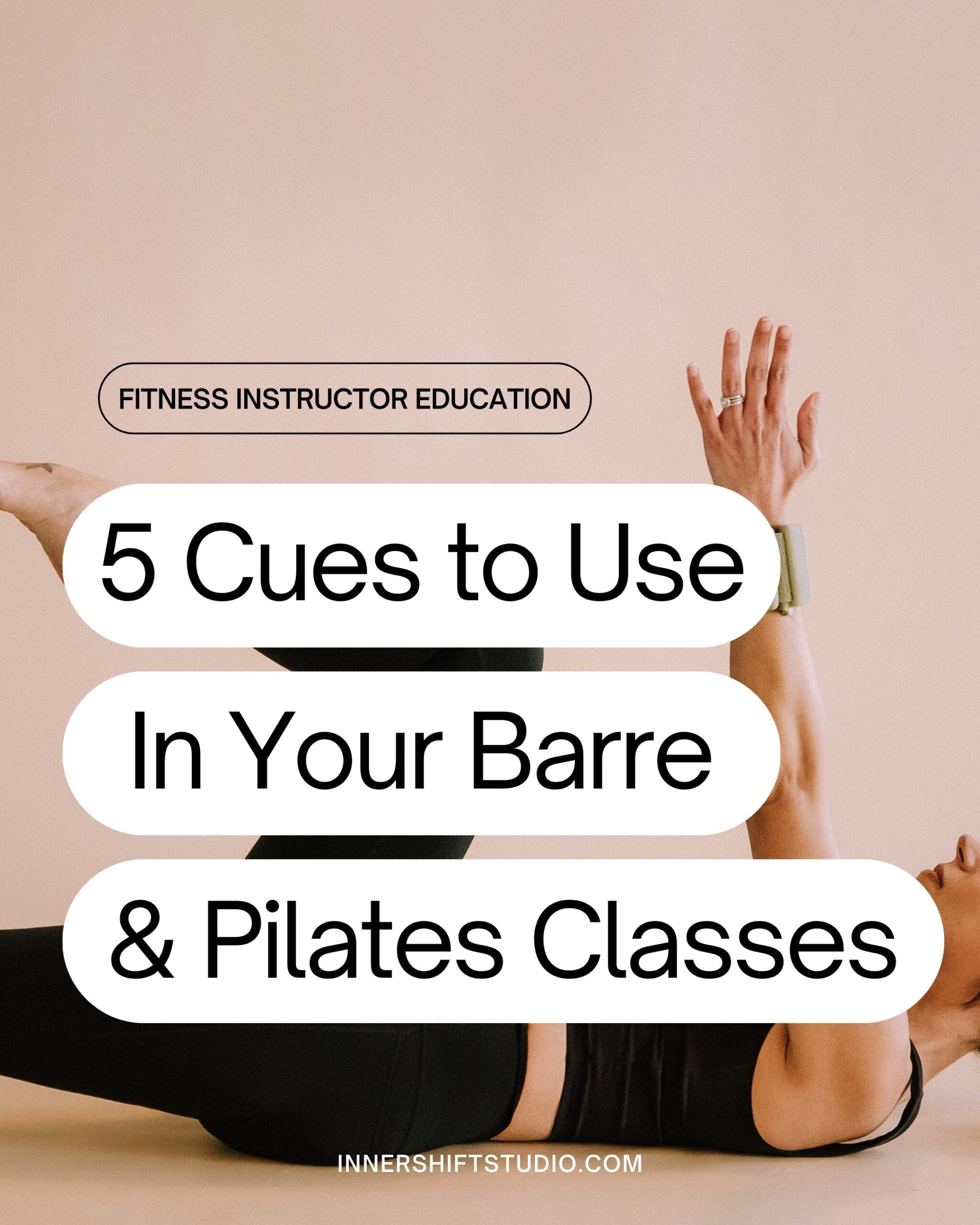Cueing is more than just giving instructions. It’s how you guide your students into presence, power, and deeper connection with their bodies.
If you’ve ever felt like you’re repeating the same phrases over and over: “engage your core,” “remember to breathe,”you’re not alone. Most instructors aren’t taught how to cue intentionally. They’re handed choreography not taught how to get people in the exercise correctly, and how to get them to really embody the exercise.
At Inner Shift Barre, cueing is a cornerstone of the method. Inside the virtual barre teacher training, I teach you 5 specific types of cues that work together to elevate your teaching, help your students feel the work, and make your classes unforgettable. Today, I’m peeling back the curtain and giving you a peek at what you’ll learn inside the Inner Shift Barre Teacher Training.
Let’s break them down:
1. SETUP CUE: This is how you kick off each exercise
Purpose:
Gives clear instructions on where to go, what equipment is needed, and how to set up before movement begins.
Why it matters:
It gets clients in a safe form, eliminates confusion, and gets them ready to move. When clients are in the right form, they’ll target the muscle group we intend for them to work during the exercise.
Examples:
-
“Grab your loop band and place it just above your knees. Step your feet hip width apart. Arms come straight out in front of you.”
-
“Stand at the top of your mat, feet hip width apart, 1 weight in each hand, palms facing in. Soft bend in your knees and roll your shoulders down your back. Hinge forward with a flat back.”
✨ Pro tip: Paint the picture. Think of this cue like setting the scene in a movie. It helps your clients visualize the setup before they move.
2. MOVEMENT CUE: This tells them “what” to do
Purpose:
You’ll use movement cues to get people moving and to cue new layers as the exercise progresses.
Why it matters:
It keeps students in flow and allows for intuitive transitions. Always practice your transitions before teaching so you can think of the best way to guide them into new layers.
Examples:
-
“We’ll start by squatting down 2 counts, then take it up 2 counts.”
-
“Next, we’ll hold it low and take tiny pulses.”
-
“Last one then you’ll catch it up and do tiny lifts at the top.”
Pro tip: Instead of just cueing the next layer, guide them into what’s next just before it happens so they know a change is coming.
3. ANATOMY CUE: Tells them what muscle group they’re working
Purpose:
Names the muscles or systems being activated to deepen body awareness and intention.
Why it matters:
It bridges the mind-body connection. When people know what they’re working, they can focus more intentionally and feel more empowered.
Examples:
-
“You’re working your transverse abdominis – the deepest layer of your core.”
-
“This focuses on your outer glute muscle”
-
“Right now you’re strengthening the tops of your thighs”
Pro tip: Before you teach an exercise, make sure you research what muscle group it’s working. The more you know about an exercise, the more confident you’ll feel teaching it.
4. FORM & FEELING CUE: Help them feel the exercise
Purpose:
Ensures alignment, safety, and deeper muscle activation. These include both physical and energetic adjustments.
Why it matters:
This is where your clients go from just doing a movement to actually feeling it and engaging the proper muscle group.
Examples:
-
“Stack your shoulders over your wrists and press evenly through all ten fingers.”
-
“Pull your belly button in towards your spine”
-
“Squeeze your bicep as you bend your arm”
✨ Pro tip: Blend form with feeling. Say one anatomical cue and follow it with a feeling cue to help clients really understand what should be happening in their body. That’s where the magic clicks.
5. MOTIVATIONAL CUE: Empower them to give it everything they’ve got
Purpose:
These are the words that encourage students to stay present, breathe deeper, and believe in their strength – especially during a challenging exercise. These motivational cues are great for adding your unique personality into a class.
Why it matters:
This is what transforms a class into an experience. Motivational cues help your students feel seen and supported – not just physically, but emotionally.
Examples:
-
“Stay with it. You’re stronger than the story in your head.”
-
“This is the moment where your mind wants to quit, but you know deep down you can stay a little longer”
-
“Let this shake be a sign that you’re changing something.”
-
“You’re not here to be perfect. You’re here to feel powerful.”
✨ Pro tip: Use their energy as feedback. If you feel them pulling back, this is your cue to turn up the encouragement.
Find Your Voice as a Fitness Instructor
Mastering cueing isn’t about sounding like anyone else. It’s about finding your voice, speaking with intention, and guiding people into deeper awareness through every rep, pulse, and breath.
That’s exactly what I teach inside the Inner Shift Barre Teacher Training.
Because when you know how to layer cueing – setup, movement, anatomy, form & feeling, and motivational – you’re not just teaching a workout. You’re holding space for transformation.
Want to learn how to cue with clarity and confidence?
👉 Explore the Inner Shift Barre Teacher Training

VIEW THE COMMENTS
5 Types of Cues To Use In Your Next Barre or Pilates Class